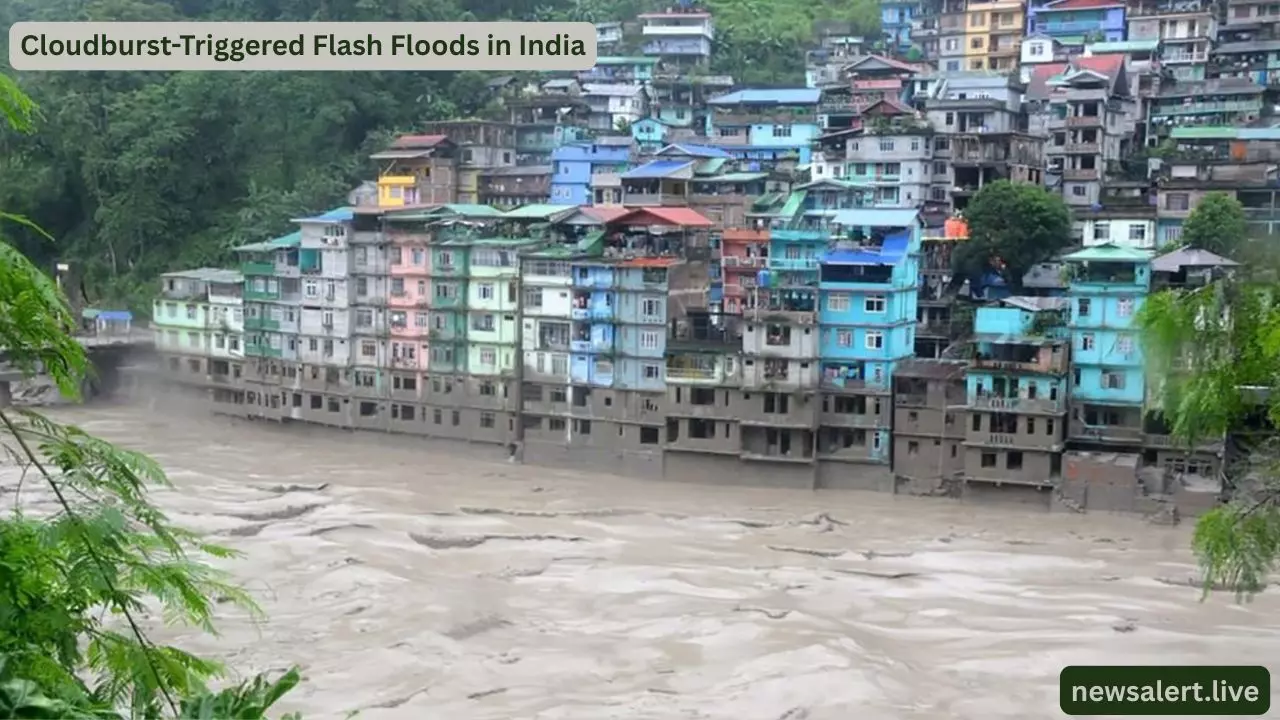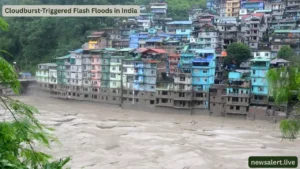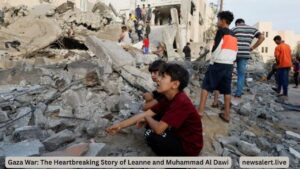A deadly cloudburst has triggered flash floods in India, leaving dozens feared trapped. Explore in-depth coverage of the disaster, rescue operations, survivors’ stories, and the climate crisis fueling such events.
Cloudburst-Triggered Flash Floods in India: Dozens Feared Trapped in Devastating Deluge
On the morning of August 3rd, 2025, disaster struck the northern Himalayan region of India when a sudden cloudburst-triggered flash flood turned tranquil mountain valleys into raging rivers of mud, rock, and destruction. Entire villages were inundated within minutes. Roads vanished, homes collapsed, and dozens were feared trapped beneath debris or swept away in the violent current.
The phrase cloudburst-triggered flash floods in India is no longer just a meteorological event—it’s a chilling reality that leaves behind sorrow, broken infrastructure, and urgent questions about climate readiness. This blog delves into every aspect of the tragedy: the science, the stories, the response, and the way forward.
What is a Cloudburst? The Silent Trigger of Chaos
A cloudburst is a localized but extremely intense rainfall event, usually over a short period and confined to a small geographic area. In hilly regions like Himachal Pradesh and Uttarakhand, such events are especially dangerous. The geography funnels rainwater into narrow gorges, turning them into deadly torrents.
In this incident, the cloudburst occurred around 3:40 AM in the Kullu district of Himachal Pradesh, dropping over 100mm of rain in less than an hour. With most residents asleep, warning time was non-existent.
“I heard thunder, then screaming. Within minutes, everything was gone,” said Kavita Thakur, a survivor.
The phenomenon of cloudburst-triggered flash floods in India is becoming alarmingly frequent. Experts link this rise to changing monsoon behavior influenced by climate change.
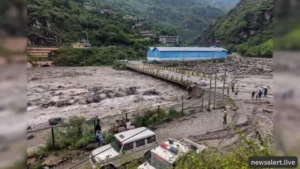
Dozens Feared Trapped: The Human Toll
Initial reports from local authorities confirmed 12 dead, 47 missing, and over 600 displaced. Small hamlets like Naggar, Manikaran, and Malana bore the brunt of the deluge. The area’s remoteness and rugged terrain hampered rescue efforts.
Among the missing were children, elderly, and even emergency workers. Eyewitnesses described watching houses collapse into rivers and hearing cries for help that vanished with the current.
The magnitude of cloudburst-triggered flash floods in India becomes horrifyingly real when you hear such voices silenced mid-scream.
Rescue agencies believe that the actual number of casualties may be higher, hidden beneath layers of mud, rock, and debris.
The Role of Social Media: Panic, Pleas, and Prayer
Mobile footage of the disaster flooded WhatsApp and Instagram. Shaky videos showed roaring rivers consuming roads, landslides crashing down, and locals yelling names of missing family members.
A single Instagram story of a trapped teenager pleading for rescue went viral, drawing national attention. Hashtags like #CloudburstIndia, #KulluFloods, and #SaveHimachal trended for 48 hours straight.
While these platforms amplified awareness, they also revealed a disturbing reality—there was no centralized emergency response channel. Many victims relied on viral reach more than formal emergency hotlines.
Rescue Operations: A Race Against Time
India’s National Disaster Response Force (NDRF), the Indian Army, and the Indo-Tibetan Border Police (ITBP) were mobilized within 12 hours. However, washed-out roads and unstable slopes slowed progress.
By Day 3, rescue helicopters airlifted over 200 people. Makeshift zip lines were set up to ferry food and medicines across raging rivers. Yet, entire areas remained inaccessible.
Officials described the operation as “one of the most challenging missions in recent memory.” The devastation from these cloudburst-triggered flash floods in India outpaced earlier rescue protocol capacity.
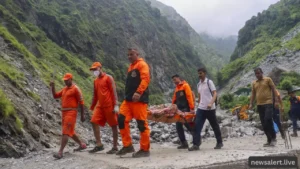
Survivors Speak: Horror, Hope, and Helplessness
33-year-old Lakhan Bhardwaj, whose house was destroyed, recounted:
“The wall just exploded. Water came in like a monster, carrying our fridge and furniture. My wife held our baby above her head until we were rescued.”
Meena Devi, an elderly woman from Manali, said:
“We’ve had floods before, but never like this. The ground shook. It felt like punishment.”
These first-hand accounts highlight the terrifying strength of cloudburst-triggered flash floods in India. They are not just weather events but humanitarian emergencies.
Government Response: Quick Words, Slow Action?
Prime Minister Narendra Modi expressed grief and sanctioned ₹2 lakh ex gratia for each deceased victim’s family. Helicopters, medics, food packages, and temporary shelters were sent to the area.
Yet, criticism mounted. Why was there no early warning system? Why did rescue teams arrive only after 10 hours? Why were bridges not reinforced despite last year’s warning?
These questions echo in every valley affected by cloudburst-triggered flash floods in India.
Climate Change: The Invisible Hand Behind Disasters
Meteorologists agree—climate change is altering India’s monsoon pattern, causing erratic rainfall. Warmer air holds more moisture, making sudden cloudbursts more likely.
Environmentalists have warned for years that deforestation, unregulated construction, and damming in the Himalayas are worsening flood risks.
This is the 5th major instance of cloudburst-triggered flash floods in India in the last 24 months.
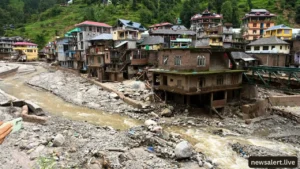
Comparison with Past Tragedies
This event mirrors the Kedarnath flood of 2013, where over 5,700 lives were lost. What has changed since then?
-
Early warning systems remain underfunded.
-
Evacuation plans are mostly theoretical.
-
Illegal constructions persist in flood-prone zones.
India’s mountain states continue to bear the brunt of preventable disasters.
What Needs to Change?
-
Invest in Predictive Technology: Real-time radar and cloud-monitoring satellites must be prioritized.
-
Disaster-Resilient Infrastructure: Rebuild using climate-adaptive designs.
-
Community Training: Villagers must be trained in basic emergency response.
-
Regulatory Reforms: No more construction in flood basins or dry riverbeds.
Without decisive action, cloudburst-triggered flash floods in India will continue to wreak havoc annually.
Conclusion: Lessons Written in Water
The tragedy in Himachal Pradesh is a warning etched in mud, blood, and loss. Nature is evolving faster than our systems. We cannot treat cloudburst-triggered flash floods in India as freak accidents anymore—they are predictable consequences of inaction.
It’s time to shift from mourning to preparing. Every year we delay action, we gamble with thousands of lives. The mountains are crying—and we must listen.
FAQs
Q1: What caused the flash floods in Himachal Pradesh in August 2025?
A cloudburst led to sudden, intense rainfall causing flash floods across mountain valleys.
Q2: How many people are feared trapped?
As per current estimates, 47 people are missing and feared trapped under debris or washed away.
Q3: Which regions were most affected?
Kullu, Manali, Malana, and surrounding areas experienced the worst damage.
Q4: How are rescue operations being carried out?
By airlifts, zip lines, and manual evacuation in flooded zones by NDRF and Army.
Q5: How does climate change relate to these floods?
Rising global temperatures increase cloudburst frequency and monsoon volatility, directly influencing flash flood risks.
Q6: How can such disasters be prevented?
Early warning systems, regulated construction, and ecological balance are key strategies.
Q7: Is this a one-time event?
No. Similar cloudburst-triggered flash floods in India have occurred multiple times in recent years.

